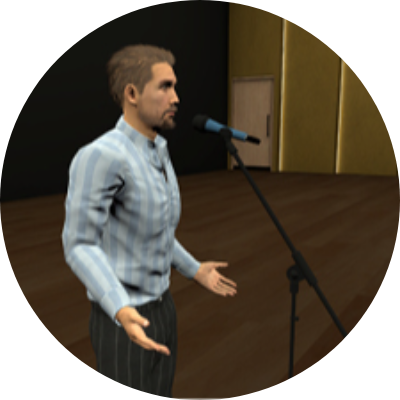 Loading...
Loading...
Initial language selection is based on your web browser preferences.

10MB
Free
Gain practical guidance and tips with public speaking courses designed to build fluency, control and confidence. Each training scenario targets a specific skill, such as maintaining eye contact with the audience or managing distractions during a presentation. Students will be able to work through a series of guided scenarios, role-plays, and training courses in a virtual setting, receiving feedback that identifies strengths and areas for improvement. This structured approach supports the development of stronger public speaking skills and enhances students' ability to deliver speeches with accuracy and confidence. **Key Features:** - Covers a wide range of communication skills including debating, how to use literary devices to achieve desired outcomes, and how to improvise - Learn through guided instruction and apply techniques in interactive, practical training scenarios - Includes moderated and one-on-one debate modes - Receive personalized feedback enabling students to reflect on performance and build speaking skills ## Content Overview: Public speaking mastery contains six training scenarios to choose from: - Debating Room (role-play) - Dealing with Distractions - Control your Emotional State - Literary Technique - Body Language Review - Impromptu Training ## Duration & Guidance: Each scenario is between five to ten minutes in duration, but times may vary depending on the user. Students can complete activities within this time frame, but for more flexible scenarios with extended interaction, we recommend taking regular breaks. Additionally, scenarios include guidance on whether to complete the training seated or standing. # TEACHING FRAMEWORK {.objective .objective} Throughout this experience, ask students to maintain a **"Communication Journal"**. This journal can be a small notebook, a stapled packet, a digital document or use the worksheet provided (see exemplar for further guidance). # Before the Experience **Initial Thoughts** Encourage self-awareness and critical thinking by having students respond to the following prompts in their journal before beginning any of the VR experiences. This reflection sets the stage for intentional practice and personal growth. - On a scale of one to five, five being the most confident, how do you feel about public speaking right now?{.task} - What do you believe makes someone a strong speaker?{.task} - What do you struggle with when speaking in front of others?{.task} - Describe a time when you had to speak in front of others. What was it about? How did it go? What would you do differently?{.task} # During the Experience **Real-Time Reflections** To support engagement and reinforce learning during each VR session, ask students to create an entry in their journal each time they complete a lesson. - *Focus – Today's lesson focused on \_\_\_.* - *Insight – One strength I saw in myself was \_\_\_. One challenge was \_\_\_.* - *Technique – I used this technique or strategy: \_\_\_. Next time, I'd like to try \_\_\_.* - *Feeling – At the start, I felt \_\_\_. But afterward I felt \_\_\_.* # After the Experience **What I Learned** To follow up, ask students to respond to the following prompts in their journal. - On a scale of one to five, five being the most confident, how do you feel about public speaking now?{.task} - Which VR lesson(s) helped you grow the most as a speaker? What did you take away from the experience?{.task} - What part of public speaking feels easier or more comfortable for you now compared to when you started?{.task} # Extended Learning **Speaker Analysis** Ask students to watch a TED Talk (student-selected or teacher-assigned) and analyze the speaker's communication techniques. While watching, students should take notes on the following in their journal: - *Body language – How does the speaker use nonverbal communication (gestures, posture, movement, etc.)?* - *Eye contact – Does the speaker establish eye contact with the audience? How?* - *Delivery – Is their voice clear and expressive? How is their pace?* - *Presence – Do they appear comfortable and in control?* - *Audience engagement – Do they use stories, questions, humor, and/or pauses to draw the audience in?* - *Feedback – What could they improve? Be constructive.* **Mini Talk Challenge** Students should prepare and deliver a two minute "mini talk" on a topic of their choice. Topics may be personal, persuasive, or informative, whatever fits your instructional goals. This activity can be facilitated live or digitally. After each talk, peers should provide simple and constructive feedback. Use the Glows and Grows protocol. Students should highlight at least one glow (a strength they noticed), along with at least one area for growth (a suggestion for improvement). # How To View Student Analytics 1. Log into VirtualSpeech website 1. Results can be viewed under 'User Analytics' by searching for the student by name